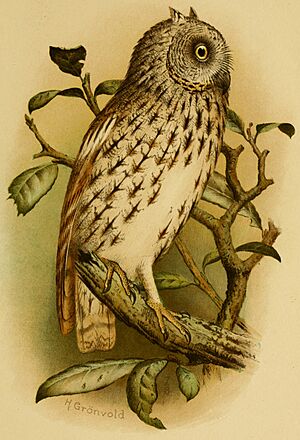Socotra scops owl facts for kids
Quick facts for kids Socotra scops owl |
|
|---|---|
 |
|
| Conservation status | |
| Scientific classification |
The Socotra scops owl (Otus socotranus) is a small owl that lives only on the island of Socotra, Yemen. When a plant or animal lives only in one place, it is called endemic. This special owl is known for its unique features and calls.
Contents
Meet the Socotra Scops Owl
The Socotra scops owl is a very small owl. It has pale sandy-grey feathers on its back. These feathers have dark streaks and bars. Its belly is lighter, with fine dark lines.
What Does It Look Like?
This owl has a plain face with soft edges. Its shoulder stripes are sandy-colored and not very clear. It has tiny ear-tufts on its head. Its eyes are bright yellow. This little owl is about 15 to 16 centimeters (6 inches) long.
What Does It Sound Like?
The song of the Socotra scops owl is a low, repeated series of notes. It sounds a bit like the call of the oriental scops owl.
Where Does the Socotra Scops Owl Live?
This owl lives only on the island of Socotra. This island is in the Indian Ocean, near the Horn of Africa. Socotra is part of Yemen.
Owl Habitat
The Socotra scops owl can be found on almost half of the island. It likes areas with mature palm trees the most. Its favorite home is rocky semi-desert areas. These places have scattered trees and bushes where the owl can hide.
How Does the Socotra Scops Owl Live?
Scientists do not know much about the daily life of the Socotra scops owl. But they have learned a few things about what it eats and how it might raise its young.
What Does It Eat?
This owl likely eats mostly insects and small animals. One owl's stomach was found to have a grasshopper, a centipede, and two lizards inside. It has also been seen catching moths at dusk. It hunts in a way similar to a nightjar, flying around to snatch insects from the air.
Reproduction and Life Cycle
Very little is known about how these owls have babies. They probably use natural holes or cracks in rocks for their nests. Scientists once found a female owl in April that seemed ready to lay eggs. Also, two 20-day-old owlets were seen in a nest in February. This suggests that the eggs were laid in early January.


